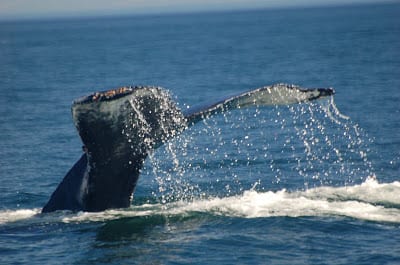 Hello everybody, it’s Danielle with Quoddy Link Marine back from a fabulous day on the Bay of Fundy. It was calm and actually quite warm on the water today (but please always bring layers, sweatshirt and a jacket, even today we gave out all of our blankets!). With the end of our evening departures we have a little more time to play with and with the help of our Scout Boat we ended up offshore on both trips today (a bit farther out in the afternoon). On our 10:00 am trip we spent time with Cork, a 5 year-old female humpback and then headed back inshore where we had a fantastic fin whale sighting and we also saw a minke whale (a 20-30 foot baleen whale). What a great trip!!
Hello everybody, it’s Danielle with Quoddy Link Marine back from a fabulous day on the Bay of Fundy. It was calm and actually quite warm on the water today (but please always bring layers, sweatshirt and a jacket, even today we gave out all of our blankets!). With the end of our evening departures we have a little more time to play with and with the help of our Scout Boat we ended up offshore on both trips today (a bit farther out in the afternoon). On our 10:00 am trip we spent time with Cork, a 5 year-old female humpback and then headed back inshore where we had a fantastic fin whale sighting and we also saw a minke whale (a 20-30 foot baleen whale). What a great trip!!
Our 2:00 pm trip took is back off the Wolves but about 4 miles further out than our morning departure. We spent some time with Cork, then got word from Matt on our Scout Boat that he was seeing a few basking sharks and another humpback whale! We made our way over and had the chance to show our passengers the second largest fish in the world, a basking shark! No need to let your Hollywood fear of sharks scare you with this guy, he has NO TEETH! Basking sharks are filter feeders, having gill rakers in their gills to catch tiny plankton. After we spent some time with the shark we made our way over to the second humpback who turned out to be Hobo, another whale we are familiar with at Quoddy Link Marine. After we spent some time with Hobo we moved closer to home and our Scout Boat let us know he was watching 2 very active finback whales. They were charging around, travelling at high speeds and blowing so hard and loud at the surface. It was an awesome trip!
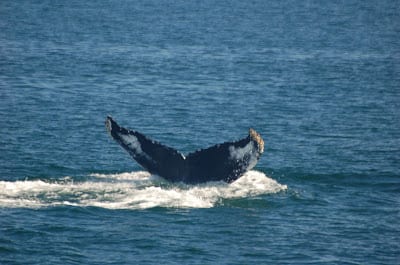 Here is Hobo. Hobo was never sighted as a calf so we are not sure of “his” age or sex.
Here is Hobo. Hobo was never sighted as a calf so we are not sure of “his” age or sex.
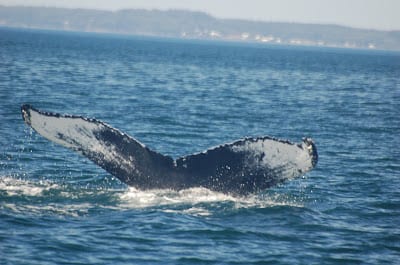 This is Cork, a 5 year old female humpback whale.
This is Cork, a 5 year old female humpback whale.
A finback whale from our morning departure. This whale was sighted right off the entrance to Head Harbour Passage, at the northern tip of Campobello Island, NB.
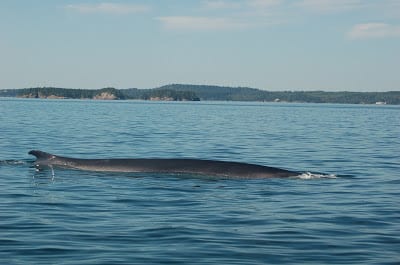 I included this image in the blog because I wanted to show you the unique markings of finback whales. Here you can clearly see the blaze and the start of the chevrons. The blaze is a white marking that extends from the lower right jaw and continues over the whales head, behind its’ blowhole. The chevrons are V-shaped markings behind the blaze. Both of these markings are unique and researchers will use photo ID to tell individuals apart.
I included this image in the blog because I wanted to show you the unique markings of finback whales. Here you can clearly see the blaze and the start of the chevrons. The blaze is a white marking that extends from the lower right jaw and continues over the whales head, behind its’ blowhole. The chevrons are V-shaped markings behind the blaze. Both of these markings are unique and researchers will use photo ID to tell individuals apart.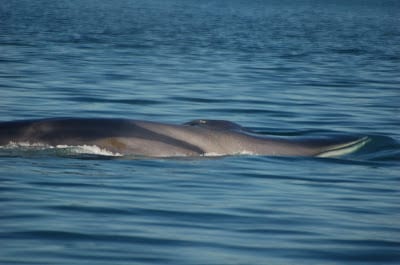 Here is a picture of the basking shark we spotted, with the help of Matt on our Scout Boat, on our 2:00 pm departure.
Here is a picture of the basking shark we spotted, with the help of Matt on our Scout Boat, on our 2:00 pm departure.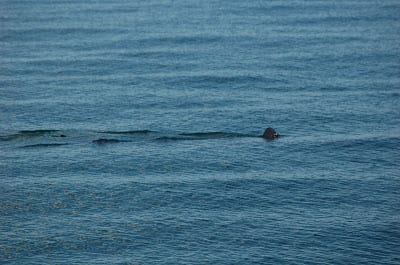 Thanks so much for checking in with us today, the weather forecast is good for tomorrow. I’ll keep you all posted on our sightings.
Thanks so much for checking in with us today, the weather forecast is good for tomorrow. I’ll keep you all posted on our sightings.


OMG Danielle your pics are awesome!! I love the gannett diving, the bald eagle, the herring, it’s all amazing! And of course, your whale photos are amazing!!!